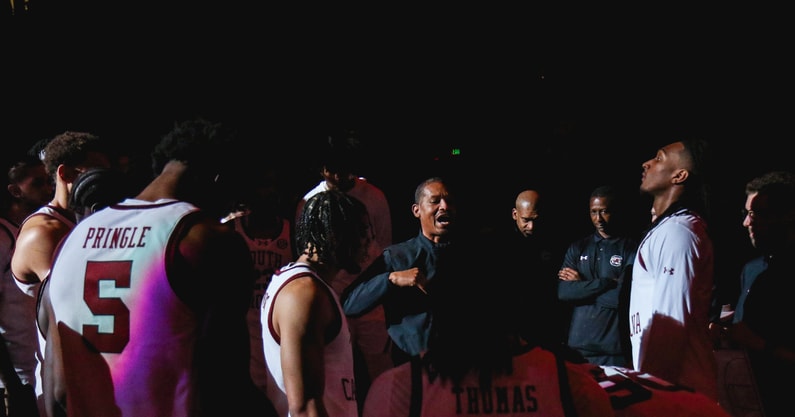Dismal Performance Prompts ESPN’s Harsh Verdict: South Carolina Men’s Basketball Season Elicits Disappointing ‘D’ Grade
The curtain has officially fallen on another college basketball season, and for the South Carolina Gamecocks men’s program, it closed with a whimper rather than a roar. Following a deeply disappointing 12-20 overall record, including a paltry 2-16 mark in SEC play, the team finds itself under the unforgiving microscope of national sports analysts. ESPN, a prominent voice in collegiate athletics, delivered a particularly stinging assessment, assigning South Carolina’s 2022-2023 campaign a resounding “D” grade. This low mark, shared only with Texas and LSU within the highly competitive Southeastern Conference, underscores the significant chasm between expectations and reality for a program desperately seeking a return to prominence.
The 2022-2023 season, the first under head coach Lamont Paris, was always going to be a rebuilding year, a notion understood by even the most optimistic Gamecock faithful. Preseason prognostications had South Carolina picked to finish 11th in the SEC, a modest projection that hinted at the challenges ahead. However, even with such tempered expectations, the final 12-20 record and the bottom-of-the-barrel conference showing failed to meet what was already a low bar. The “D” grade from ESPN’s Myron Medcalf, who meticulously reviewed each SEC program, characterized the season as a “nightmare,” a stark contrast to the “dream” scenario that unfolded just a year prior when the Gamecocks unexpectedly earned an NCAA Tournament bid. This recent struggle is particularly pronounced when contrasted with the success of the women’s program, which consistently contends for national championships, creating a distinct dichotomy within the university’s basketball landscape.
A closer examination of the 2022-2023 season reveals a multitude of factors contributing to this dismal outcome. Offensively, South Carolina struggled mightily to put points on the board, often appearing disjointed and lacking consistent scoring threats. They ranked near the bottom of the SEC in points per game, highlighting their inability to generate efficient offense against conference opponents. While the team showed glimpses of defensive tenacity at times, ranking in the middle of the pack for points allowed, their offensive struggles often negated any positive defensive performances. This imbalance created a frustrating cycle, where good defensive stands were frequently undone by missed opportunities on the offensive end. The team’s assist-to-turnover ratio, another critical indicator of offensive efficiency, was also a significant concern, further emphasizing a lack of cohesive ball movement and decision-making.
The competitive landscape of the SEC further amplified South Carolina’s struggles. The conference, long known for its physicality and talent, saw 13 of its 16 teams earn a ‘B’ grade or higher from ESPN. This disparity highlights not only South Carolina’s internal shortcomings but also the immense challenge of competing in a league where the level of play continues to rise. Teams like Alabama, Tennessee, and Auburn consistently demonstrated high-level offensive and defensive schemes, boasting rosters replete with future NBA talent. South Carolina, in comparison, often found itself outmatched in terms of depth, experience, and overall talent, particularly in crucial stretches of conference play. Road games, in particular, proved to be an almost insurmountable hurdle, with the Gamecocks managing just one win away from home throughout the entire season. This inability to perform consistently outside of Colonial Life Arena spoke volumes about the team’s mental fortitude and readiness for the rigors of high-level college basketball.
Despite the overwhelmingly negative assessment, Medcalf did offer a glimmer of optimism, acknowledging that South Carolina managed to secure victories against three NCAA Tournament-bound teams. Among these notable wins was an exciting 91-88 overtime triumph against in-state rival Clemson at home. These victories, while few and far between, demonstrated the team’s potential on rare occasions, proving they were capable of competing with and even defeating stronger opponents when all the pieces aligned. However, these flashes of brilliance were ultimately overshadowed by the prolonged periods of inconsistency and struggle, preventing any meaningful momentum from being built.
Looking ahead, the road to recovery for South Carolina basketball appears fraught with further challenges. The departure of key players, notably the decision of Collin Murray-Boyles to stay in the NBA Draft, creates significant voids that Lamont Paris and his coaching staff must address. Murray-Boyles was projected by many as a potential first-round pick, and his absence will undoubtedly be felt on both ends of the court. Beyond him, the Gamecocks are faced with the daunting task of replacing six of the seven players who started a game last season, signaling a near-complete roster overhaul. This level of turnover, while offering an opportunity for new talent to emerge, also presents a substantial hurdle in terms of building chemistry and continuity. Recruiting and the transfer portal will be paramount in the coming months as the program attempts to inject much-needed talent and experience into its ranks. The coaching staff will need to be aggressive and shrewd in identifying players who can not only contribute immediately but also fit the long-term vision for the program.
The low grade from ESPN serves as a sobering reminder of the distance South Carolina men’s basketball must travel to regain competitive relevance in the SEC and on the national stage. It underscores the need for strategic recruitment, sustained player development, and a clear tactical identity. The 2022-2023 season was a painful lesson, a stark illustration of the challenges inherent in a rebuilding process. While the “D” grade may sting, it also provides a clear benchmark for improvement. The hope for Gamecock fans now rests on the ability of Coach Paris and his staff to learn from the past season’s shortcomings, adapt their strategies, and ultimately transform a “nightmare” into a future “dream” scenario, mirroring the success that their women’s counterparts have so consistently achieved. The journey will be long and arduous, but the ambition remains: to elevate South Carolina men’s basketball from the bottom of the conference standings to a program that can consistently compete with the nation’s best.



